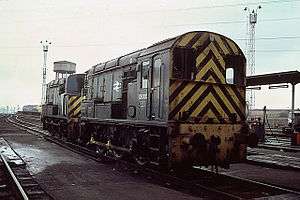| British Rail Class 13 |
|---|
 |
|
|
|
|
|
|
| Career |
|---|
| Operators |
British Railways |
|---|
| Numbers |
D4500–D4502, later 13001–13003 |
|---|
| Axle load class |
RA 8 |
|---|
| Retired |
1983–1986 |
|---|
| Disposition |
All scrapped |
|---|
|
The British Rail Class 13 was a type of diesel-electric shunting locomotive. The type was designed in 1965 because of the need to provide more powerful shunters for the Tinsley Marshalling Yard. Because of Tinsley's status as a hump yard, it was not possible to use a single locomotive owing to the risk of grounding. So, to achieve the required power, a pair of Class 08 shunters were permanently coupled in 'master and slave' formation, with the slave unit having had its cab removed. Both units were then ballasted to improve traction. Initially coupled cab-to-cab, it was found more practical to couple master nose to slave cab.
Withdrawal
With the end of hump shunting at Tinsley the class became obsolete. The unique qualities of the locomotives were not required elsewhere and so withdrawal was inevitable; 13002 was withdrawn in 1983, with the remaining two locomotives going with the closure of Tinsley hump in 1985. None of this unusual class survives.[1]
Units
Three pairs were formed as follows:
| Unit number |
Master unit |
Slave unit |
Withdrawn |
Fate |
Notes |
|---|
| Original |
TOPS |
| D4501 |
13001 |
D4190 |
D4189 |
January 1985 |
Scrapped at BREL Swindon, May 1985 |
[2] |
| D4502 |
13002 |
D4187 |
D3697 |
June 1981 |
Scrapped at BREL Swindon, October 1982 |
[3] |
| D4500 |
13003 |
D4188 |
D3698 |
January 1985 |
Scrapped at BREL Doncaster, September 1986 |
[4] |
References
- ↑ Bickerdyke, Paul, ed. (October 2015). "Class 13 Tinsley shunters". Rail Express. No. 233. Horncastle: Mortons Media Publishing. p. 25. ISSN 1362-234X.
- ↑ "Class 13 Number 13001". Diesel/Electric Locomotive Information. Rail UK. Retrieved 28 March 2017.
- ↑ "Class 13 Number 13002". Diesel/Electric Locomotive Information. Rail UK. Retrieved 28 March 2017.
- ↑ "Class 13 Number 13003". Diesel/Electric Locomotive Information. Rail UK. Retrieved 28 March 2017.
- Strickland, David C. (1983). Locomotive Directory—every single one there has ever been. Camberley, Surrey: Diesel and Electric Group. pp. 53–55. ISBN 0-906375-10-X.
Further reading
- McManus, Michael. Ultimate Allocations, British Railways Locomotives 1948 - 1968. Wirral. Michael McManus.
- Pobgee, Ray (February 1983). "We're two of a kind...". Rail Enthusiast. EMAP National Publications. pp. 22–23. ISSN 0262-561X. OCLC 49957965.
External links
British railway locomotives and miscellany, 1948 to present |
|---|
| Diesel shunters | |
|---|
Diesel shunters
(pre-TOPS) | |
|---|
| Main-line diesels: | |
|---|
Main-line diesels
(pre-TOPS) | |
|---|
| Electrics | |
|---|
Electrics
(pre-TOPS) | |
|---|
| Departmental | |
|---|
| Prototypes | |
|---|
| Getlink locomotives | |
|---|
| Steam locomotives | |
|---|
| Ships | |
|---|
|
